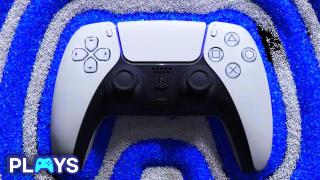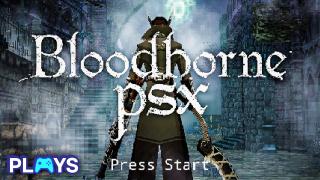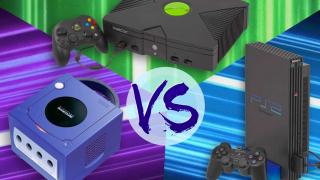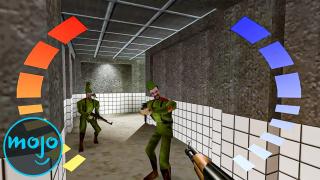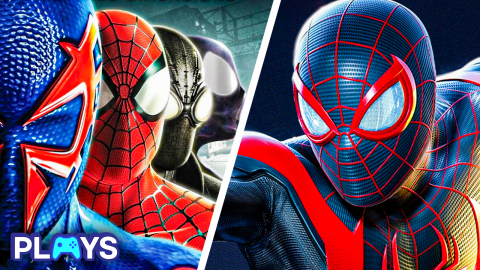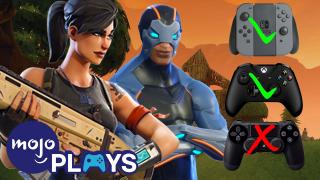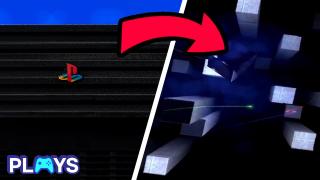The controller; synonymous with gaming, and as self-descriptive as a piece of hardware gets. Thumbsticks, buttons, paddles, bongo drums, hand gestures… It’s how we connect directly with the actions and characters in a game and without a controller we would be condemned to just stare at the start screen.
Keep in mind that if you make a purchase through any of our affiliate links below, WatchMojo may earn a commission. Thank you for your support, as it allows us to continue creating content for our audience.
Recently, we sat down with Adam Coe, the CEO and founder of Evil Controllers, a group of dedicated developers and professionals who give your controllers an evil touch.
And together, we’re going to bring you the complete history of gaming’s most important and memorable video game peripheral – the controller.

“It started back in 2007, in my dorm room at the university of Arizona. At the time I was an avid Halo 2 player, playing my 5, 6, 7 hours a day and I simply wanted to improve my play style†said Adam.

Chapter 1 – The Origin
The very first game controller dates back to the late 50’s when American physicist William A. Higinbotham used an oscilloscope to create the world’s first video game – “Tennis for Twoâ€. This simple game was played with only a knob and a button. The whole thing only took a few weeks for Higinbotham and a technician to assemble. Despite a successful showing at the Brookhaven National Laboratory Expo, Higinbotham would not pursue further into developing games. Little did he know this would spark an entire industry.

It wasn’t until the 1970’s when we started seeing more diverse (and awkward) controllers. Many retained the idea of knobs, dials, and buttons, but some went a little too over-the-top. The RCA Studio II, for example, looked like an oversized calculator. Then, you had controllers like the Coleco Telstar Arcade’s, which attempted to incorporate three different controllers with one peripheral – one with knobs, one with a steering wheel, and one with a plastic handgun. (Yeah, we can’t make stuff like THAT these days…) Shockingly enough, a handful of these controllers did support eight-way directional inputs such as the Fair Channel F console.

We didn’t start seeing the joystick we’ve come to know until 1977 when Atari introduced the Atari 2600. With its simplistic design, featuring four-way directional input and a single button, the 2600’s controller made playing games feel much more intuitive than the more complex nature of their competitors.

So, why did it take us so long to get to the point between 1958 when Higinbotham developed “Tennis for Two†and 1977 when the Atari 2600 debuted? It is important to know that video games were still brand new, and we were still trying to figure out how games should be played. Adam points out that delayed communication between developers and consumers hindered progress.
“I sympathized with the developers from back in the 70s, 80s and 90s because of the resources and structure of the world at the time, you know without having the internet and the consumer feedback everything is so delayed. You created a product, it releases, you hope it does well, you get that feedback and you have to implement that feedback. And this is all with significant delays in communication†remarked Adam.
Enter Nintendo in 1980. After spending years creating playing cards and toys, the House that Mario would soon build sought after other business ventures. Originally hired as a technician, Gunpei Yokoi was brought on to help Nintendo with the expansion. While the company would see success with Yokoi’s “Ultra Hand†toy and the Color TV Game systems, Nintendo wanted Yokoi and his team to do something that wasn’t the hundredth variation of “Pongâ€. In 1980, Yokoi and Nintendo would introduce a miniature device known as the “Game & Watch†series. The games started out with two buttons to move characters – one to move the player character right, and one to move them left. It wouldn’t be long before these handheld games would implement four buttons, but they would be a little uncomfortable to press. To fix this, Yokoi traded the buttons for a small, cross-shaped lever that could be programmed for eight directions. This was what we now know as the “D-padâ€.

The controller’s next milestone would occur a few years after the events of the “Game & Watch†series when Nintendo had their eyes on the home console market. The only problem was that they also wanted their product to be more accessible unlike the obscenely priced machines from their competitors. Deciding to get rid of the keyboard entirely, Nintendo found that they would need to create a new way for players to communicate with games. Introducing the Nintendo Entertainment System, which came with the already revolutionary D-pad dedicated to one side. Of course, this wasn’t the only reason why the NES succeeded with its controller.
“I would imagine at the time, in that age they found it very simple to use as they were playing Mario with just a few buttons and so from that perspective I thought it was a perfect starting point to a video game controller†said Adam.
And how did Nintendo’s competitors handle this success? Well, Atari certainly wasn’t turning heads with its odd, remote control hybrid, and the Jaguar’s controller wasn’t any better, causing the manufacturer to dip out of the console market entirely. The Commodore 64 Games System, on the other hand, would try to bring joysticks back and keep keyboards with home consoles. Alas, the system never caught on. SEGA, Sony, and SNK would attempt their own formats while still using Nintendo’s blueprint of “d-pad on left, face buttons on rightâ€.

https://www.businessinsider.com/sega-genesis-mini-game-list-2019-4
Adam states “The only thing I really think that could make an improvement to the controllers back then is kinda obvious now, but simply being wireless.â€
Chapter 2 – Improving The Standard
Back in the early years of video games, durability wasn’t much of a thought. The 1962 game “Spacewar!†required users to be extremely careful with the machine as it was easy for someone to accidentally flip the power off. However, controllers wouldn’t be so fragile as to cause accidental shutdowns. Adam recalls controllers, even back then, being pretty sturdy.
“As a kid, controllers were really durable and I remember the cartridges of course needing to be blown in but the controllers themselves seemed like they could withstand anything with how durable they were.â€

https://en.wikipedia.org/wiki/PlayStation_2
As we entered the sixth generation of home consoles with the Nintendo GameCube, SEGA Dreamcast, Sony PlayStation 2, and Microsoft’s original Xbox, one can notice where durability was becoming more of a priority. The GameCube, Xbox, and Dreamcast utilized rather bulky controllers. One could feel how compact their parts were. Clearly, the gaming giants were wanting players comfortable and unable to smash controllers easily.
“Games and controllers go hand in hand with influencing each other. It just depends on the current times, of the type of game and the current available hardware.â€
Although, before we got our grubby hands on these consoles, controllers had reached another milestone. In 1996 Nintendo released the Nintendo 64 console with an analog stick to allow for smoother movement in a 3D environment. A year later, Sony introduced a reworked version of the original PlayStation controller – the first DualShock.

“And to improve the game they created, you know, analog thumbsticks that allows you to have more control so you know it took a little bit of back and forth and now its a standard but without those thumbsticks you’re unable to enjoy the game as well as you could and therefore they are a direct impact on each other.â€
Not only did this prevent blisters from that incredibly rough D-pad by offering dual analog sticks, but it gave developers more ways to let players control the game’s camera and make it easier to navigate through games. Indeed, analog sticks were quite the innovation back then.
“I mean, I think we can all say that we remember first trying those going into a game and looking up at the sky, turning around and not even being able to play. And to think that that didn’t exist previously whereas now it’s a necessity.â€

Adam cites another innovation, one that is often overlooked or easily dismissed – rumble. A few months before Sony launched the first DualShock, Nintendo introduced the Rumble Pak. What’s so special about making a controller vibrate? Well, there’s more to it than just shaking the controller. This has now become a way for developers to effectively communicate errors to the player in addition to immersing them in the game world. We’ve scoffed at things like the Nintendo Switch’s HD Rumble, but this aspect of game design is just as important as thumb sticks.
We take thumbsticks and rumble for granted these days. However, if it wasn’t for these innovations, we wouldn’t be enjoying shooters and fighting games as often as do now. Because of these, our shots are more accurate, our combos can be pulled off quicker, and we can execute complex inputs without straining our hands. Now that we’ve reached this achievement, we’ve caught ourselves at a crossroads.
Chapter 3 – Perfection: The Impossible Goal
The eighth generation may not have accomplished anything too outstanding, but it defines our impossible goal of making things perfect. Adam says the most challenging demand right now is making a controller that meets every demand for every particular play style.
“And making it a great experience, creating your own controller on a controller creator and really engaging in all the different features that we offer.â€

Sony’s DualShock 4 and Xbox’s new controller for the Xbox One have included sensitive triggers and improved rumble features, giving players more feedback than ever before. Their controller plating has gotten tougher, too! As for the Plumber’s Palace, Nintendo has managed to include several control schemes in a single console with the Switch.
However, as gaming has grown and become more popular, we’re finding new problems with our standard controller. How can we make gaming more accessible to those with limited mobility? How can those suffering from muscular dystrophy or have gone through amputation get in on the fun and feel included? While Xbox has introduced their own adaptive controller in 2018, other companies like Evil Controllers are offering to develop special controllers for disabled players.

“Successful gaming is the ability to allow gamers with limitations to game. So this is something that I’m extremely passionate about. We offer products for these gamers that are so customized that it’s unique to their exact playing style and whether it’s muscular dystrophy or cerebral palsy, an amputee, we’re able to design controllers for these gamers.â€
With these ambitions in place for the industry, where can controllers go from here? We’ve already gotten glimpses of where Sony and Microsoft are wanting to take things. With their Elite series, Xbox is looking to bring customization so players can play games with the best control scheme possible. As for Sony’s new DualSense controller, the gaming giant is planning to incorporate adaptive feedback in its triggers and vibration as well as a built-in microphone to allow easier communication between players.

One thing companies need to recognize is that the controller is the connection between you and the character.
“I think they’ve identified the controller is what connects you to the game and by integrating things like haptic feedback and even audio into the controller, it’s really bringing a focus back to the controller from not just the functionality standpoint but from the hardware and feature standpoint.â€
It’s also important that the next wave of controllers keeps both casual gamers and hardcore gamers in mind as Adam points out.
“Hardcore gamers have different playing styles right, than a casual gamer. A casual gamer may play 10 to 15 hours a week where a hardcore gamer might be 50, 60 or even more. And with that there comes wear and tear on your controller, so we have to create controllers that can withstand that wear and tear. It’s expected with this equipment.â€
So, where would be without all of these innovations? Would we still be able to detect hits more easily without rumble? Would we still be using D-pads had Sony not launched the DualShock or if Nintendo never went forward with “Game & Watchâ€? Would we be enjoying the many games we’re spoiled with today had we not incorporated some of these features? The controller is much more important than we realize. It’s something we take for granted, something that gets more beatings for frustrating gameplay than it rightfully deserves. So, keep them clean, and don’t rage so much. Who knows how much longer we’ll have with them before they’re discontinued? …Or when we make the giant leap to hands-free controls like the Kinect. That was ugly to imagine!
“The next generation controllers probably are gonna have significant improvement to the thumbsticks and that’s something that I would like to see being that it’s been 9 years since the last release I would expect from a hardware standpoint that we would see a tremendous improvement.â€
And on that note, we’ll leave you with some Microsoft Kinect memes!


If you want a more in-depth look at the evolution of video game controllers, you can watch the video here.











